1998 CHEVROLET CAVALIER steering wheel
[x] Cancel search: steering wheelPage 217 of 400
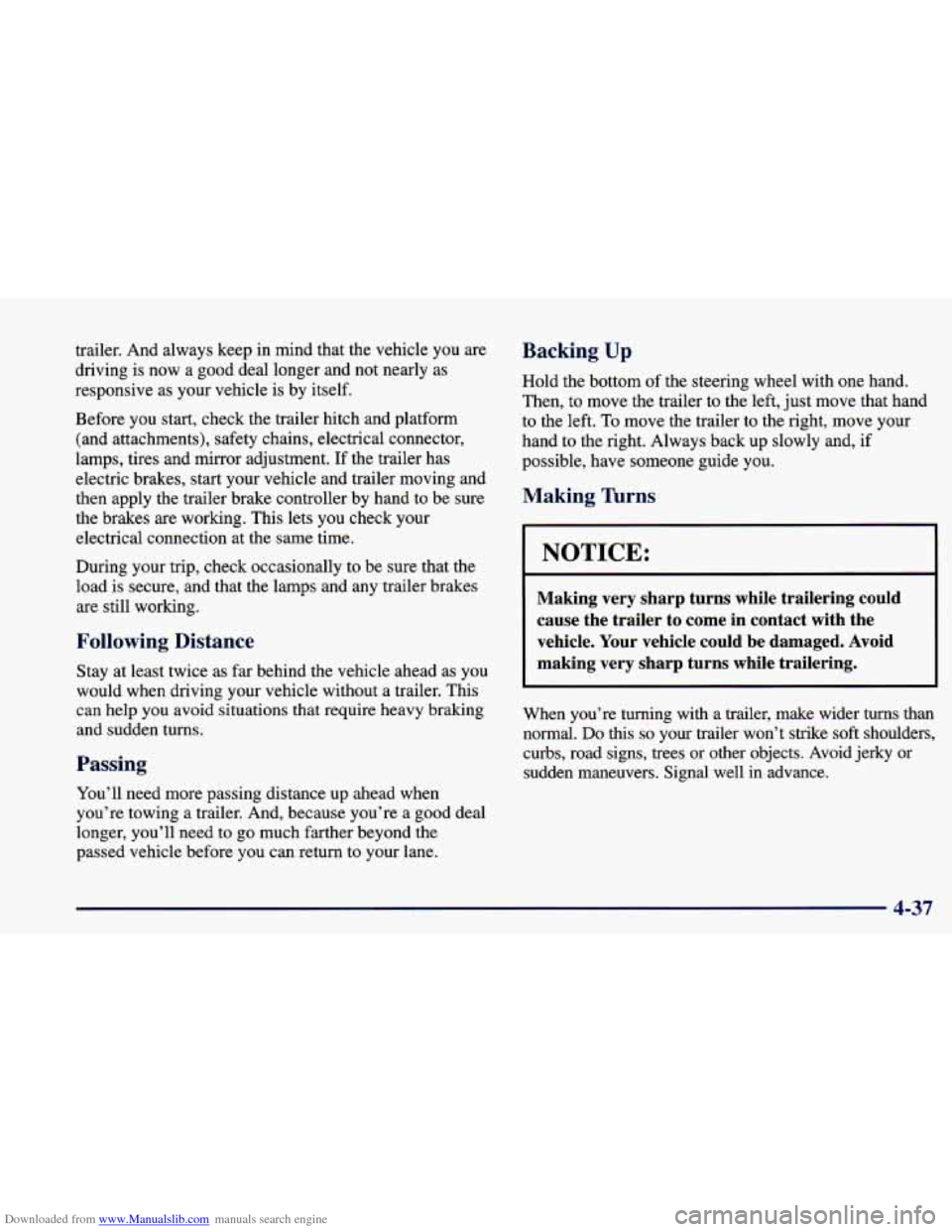
Downloaded from www.Manualslib.com manuals search engine trailer. And always keep in mind that the vehicle you are
driving is now a good deal longer and not nearly as
responsive as your vehicle is by itself.
Before you start, check the trailer hitch and platform
(and attachments), safety chains, electrical connector,
lamps, tires and mirror adjustment.
If the trailer has
electric brakes, start your vehicle and trailer moving and then apply the trailer brake controller by hand to be sure
the brakes
are working. This lets you check your
electrical connection at the same time.
During your trip, check occasionally to be sure that the
load is secure, and that the lamps and any trailer brakes
are still working.
Following Distance
Stay at least twice as far behind the vehicle ahead as you
would when driving your vehicle without a trailer. This
can help you avoid situations that require heavy braking
and sudden turns.
Passing
You’ll need more passing distance up ahead when
you’re towing a trailer. And, because you’re a good deal
longer, you’ll need to go much farther beyond the
passed vehicle before you can return to your lane.
Backing Up
Hold the bottom of the steering wheel with one hand.
Then, to move the trailer to the left, just move that hand
to the left. To move the trailer to the right, move your
hand to the right. Always back up slowly and, if
possible, have someone guide you.
Making Turns
NOTICE:
Making very sharp turns while trailering could
cause the trailer to come in contact with the
vehicle. Your vehicle could be damaged. Avoid
making very sharp turns while trailering.
When you’re turning with a trailer, make wider turns than
normal. Do this
so your trailer won’t strike soft shoulders,
curbs, road signs, trees or other objects. Avoid jerky or
sudden maneuvers. Signal well in advance.
4-37
Page 231 of 400
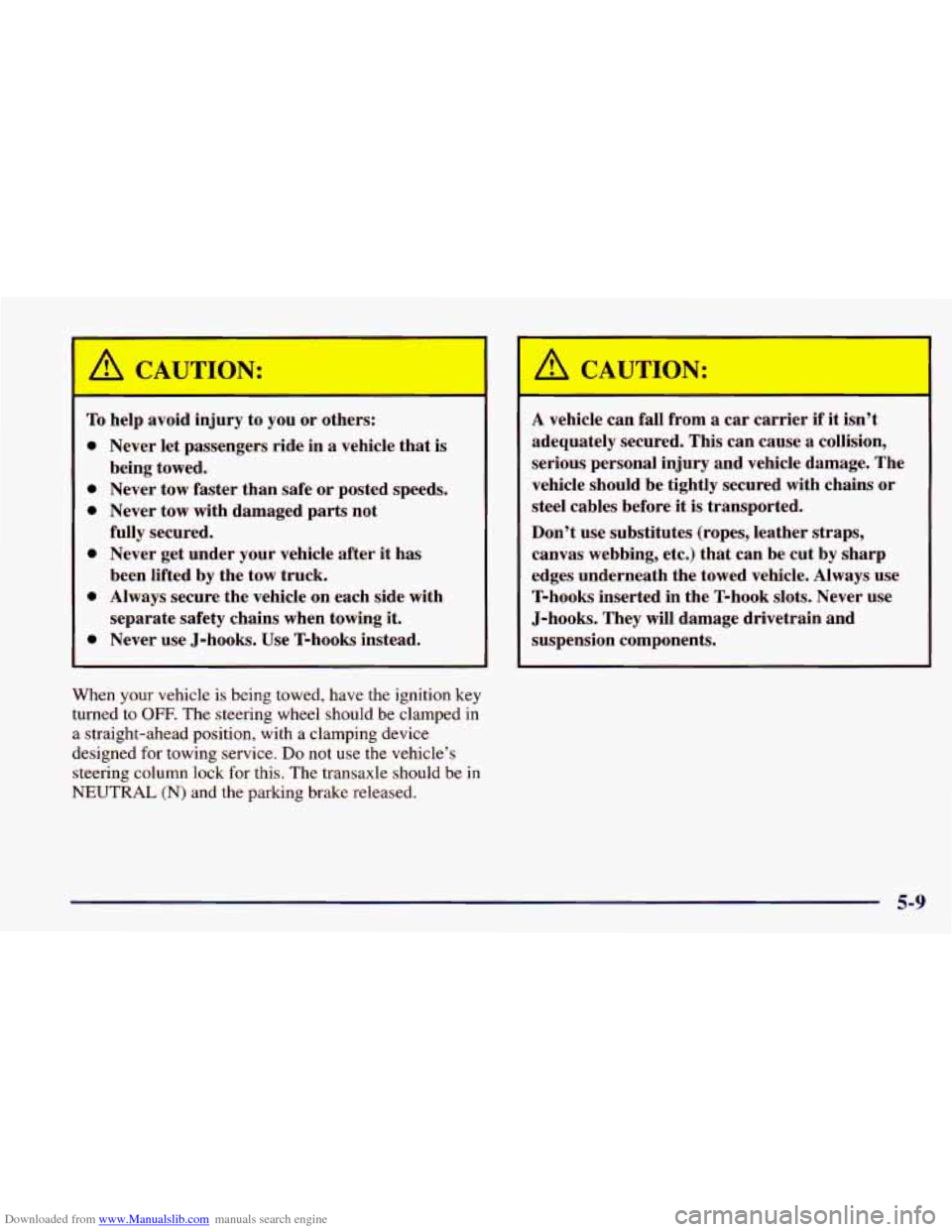
Downloaded from www.Manualslib.com manuals search engine A CAUTION:
To help avoid injury to you or others:
0 Never let passengers ride in a vehicle that is
0 Never tow faster than safe or posted speeds.
0 Never tow with damaged parts not
fully secured.
0 Never get under your vehicle after it has
been lifted by the tow truck.
0 Always secure the vehicle on each side with
separate safety chains when towing it.
0 Never use J-hooks. Use T-hooks instead.
being towed.
When your vehicle is
being towed, have the ignition key
turned
to OFF. The steering wheel should be clamped in
a straight-ahead position, with a clamping device
designed
for towing service. Do not use the vehicle’s
steering column lock for this. The transaxle should be in
NEUTRAL (N) and the parking brake released.
’ A CAUTION:
A vehicle can fall from a car carrier if it isn’t
adequately secured. This can cause a collision,
serious personal injury and vehicle damage. The
vehicle should be tightly secured with chains or
steel cables before it
is transported.
Don’t use substitutes (ropes, leather straps,
canvas webbing, etc.) that can be cut by sharp
edges underneath the towed vehicle. Always use
T-hooks inserted in the T-hook slots. Never use
J-hooks. They will damage drivetrain and
suspension components.
5-9
Page 245 of 400
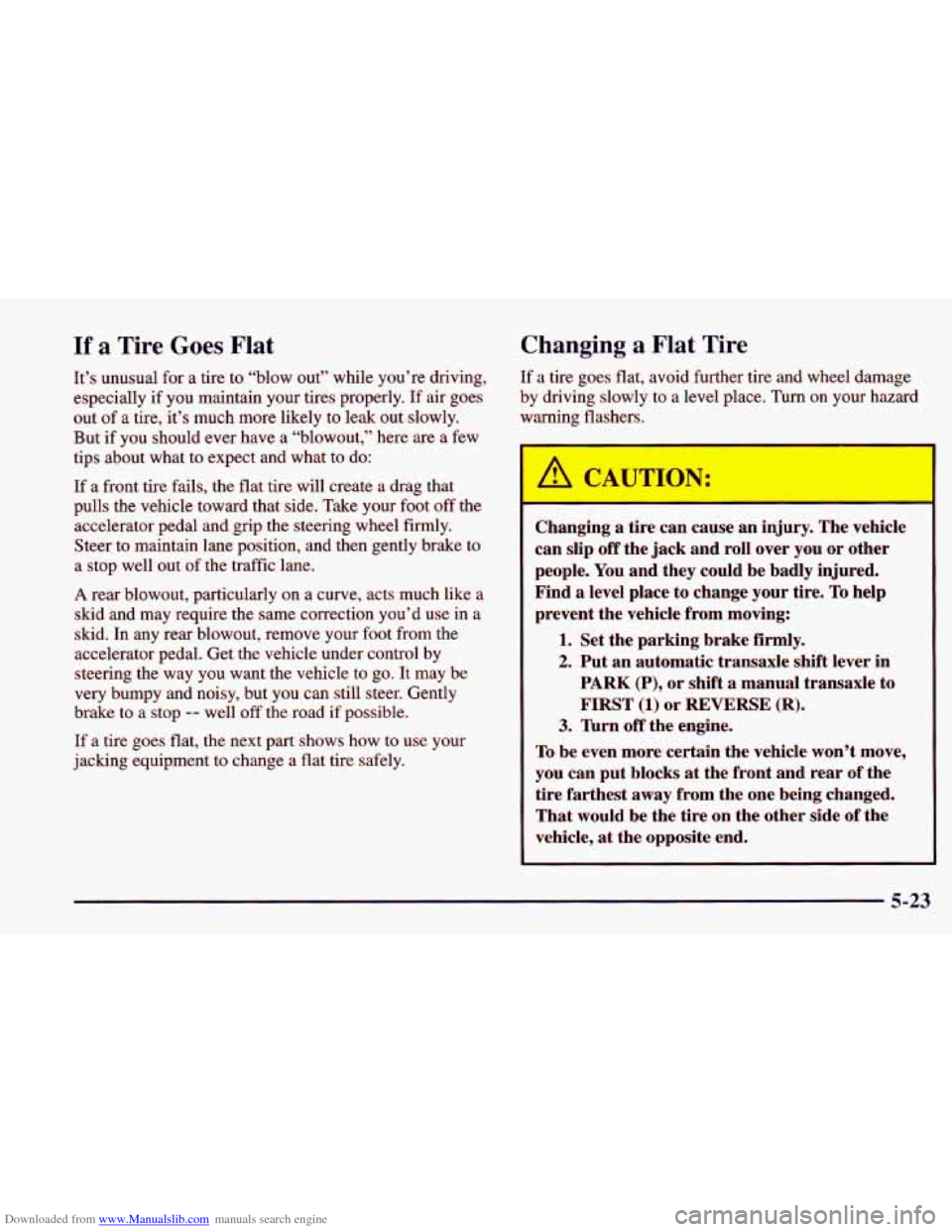
Downloaded from www.Manualslib.com manuals search engine If a Tire Goes Flat Changing a Flat Tire
It’s unusual for a tire to “blow out” while you’re driving,
especially if you maintain your tires properly. If air goes
out
of a tire, it’s much more likely to leak out slowly.
But if you should ever have a “blowout,” here are a few
tips about what to expect and what to do:
If a front tire fails, the flat tire will create a drag that
pulls the vehicle toward that side. Take your foot
off the
accelerator pedal and grip the steering wheel firmly. Steer to maintain lane position, and then gently brake to
a stop well out of the traffic lane.
A rear blowout, particularly on a curve, acts much like a
skid and may require the same correction you’d use in a
skid. In any rear blowout, remove your foot from the
accelerator pedal. Get the vehicle under control by
steering the way you want the vehicle to go.
It may be
very bumpy and noisy, but you can still steer. Gently
brake to a stop
-- well off the road if possible.
If a tire goes flat, the next part shows how to use your
jacking equipment to change a flat tire safely.
If a tire goes flat, avoid further tire and wheel damage
by driving slowly to a level place. Turn on your hazard w--+q- ‘?ashers.
I
Changing a tire can cause an injury. The vehicle
can slip
off the jack and roll over you or other
people. You and they could be badly injured.
Find
a level place to change your tire. To help
prevent the vehicle from moving:
1. Set the parking brake firmly.
2. Put an automatic transaxle shift lever in
PARK (P), or shift a manual transaxle to
FIRST (1) or REVERSE (R).
3. nrn off the engine.
To be even more certain the vehicle won’t move,
you can put blocks
at the front and rear of the
tire farthest away from the one being changed.
That would be the tire on the other side
of the
vehicle,
at the opposite end.
5-23
Page 256 of 400
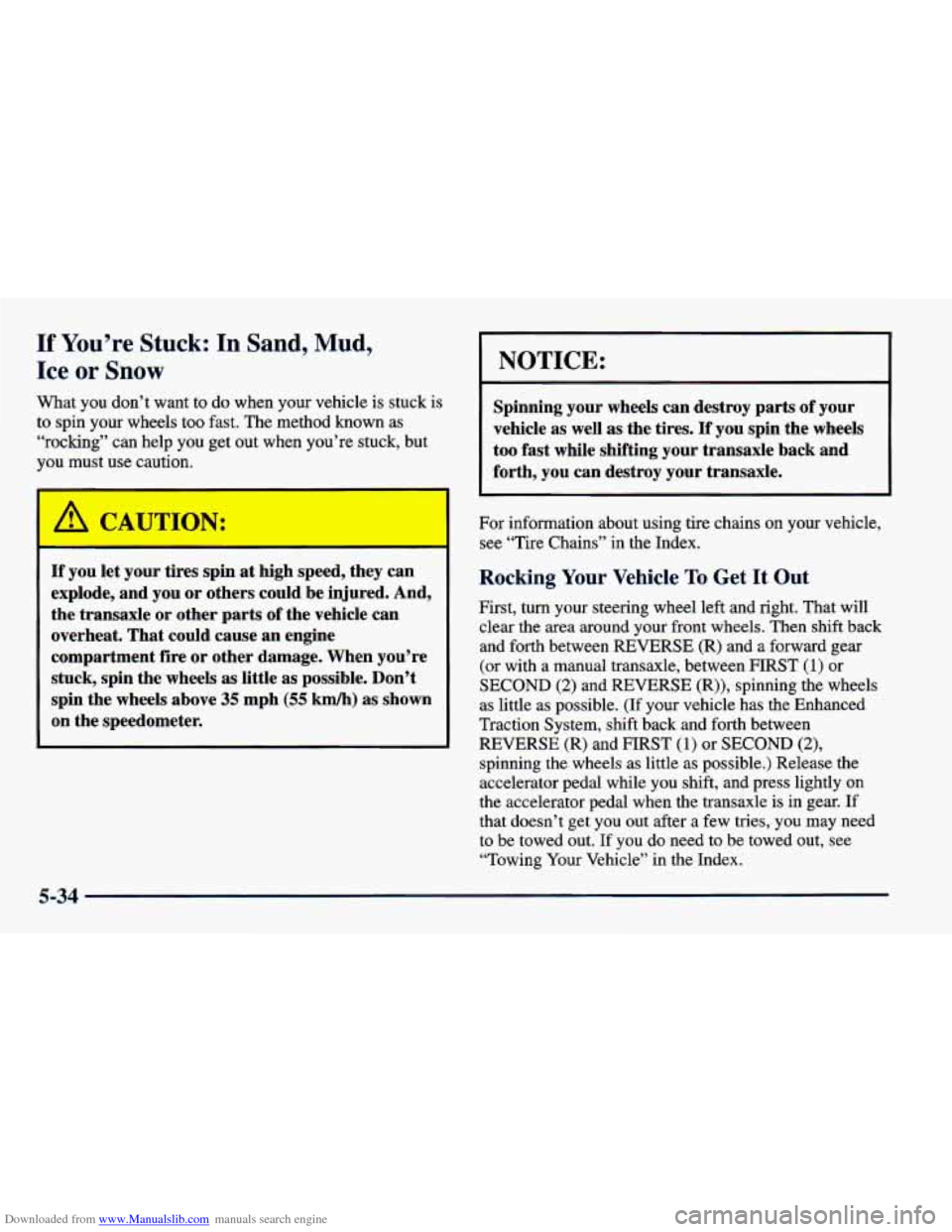
Downloaded from www.Manualslib.com manuals search engine If You’re Stuck: In Sand, Mud,
Ice or Snow
What you don’t want to do when your vehicle is stuck is
to spin your wheels too fast. The method known as
“rocking” can help you get out when you’re stuck, but
you must use caution.
I
NOTICE:
Spinning your wheels can destroy parts of your
vehicle as well
as the tires. If you spin the wheels
too
fast while shifting your transaxle back and
forth, you can destrov vour transaxle.
If you let your tires spin at high speed, they can
explode, and
you or others could be injured. And,
the transaxle
or other parts of the vehicle can
overheat. That could cause an engine
compartment fire
or other damage. When you’re
stuck, spin the wheels as little as possible. Don’t
spin the wheels above
35 mph (55 km/h) as shown
on the speedometer.
For information about using tire chains on your vekfe,
see “Tire Chains” in the Index.
Rocking Your Vehicle To Get It Out
First, turn your steering wheel left and right. That will
clear the area around your front wheels. Then shift back and forth between REVERSE (R) and a forward gear
(or with a manual transaxle, between FIRST
(1) or
SECOND
(2) and REVERSE (R)), spinning the wheels
as little as possible.
(If your vehicle has the Enhanced
Traction System, shift back and forth between
REVERSE (R) and FIRST
(1) or SECOND (2),
spinning the wheels as little as possible.) Release the
accelerator pedal while you shift, and press lightly on
the accelerator pedal when the transaxle is in gear. If that doesn’t get
you out after a few tries, you may need
to be towed out. If you do need to be towed out, see
“Towing Your Vehicle” in the Index.
5-34
Page 359 of 400
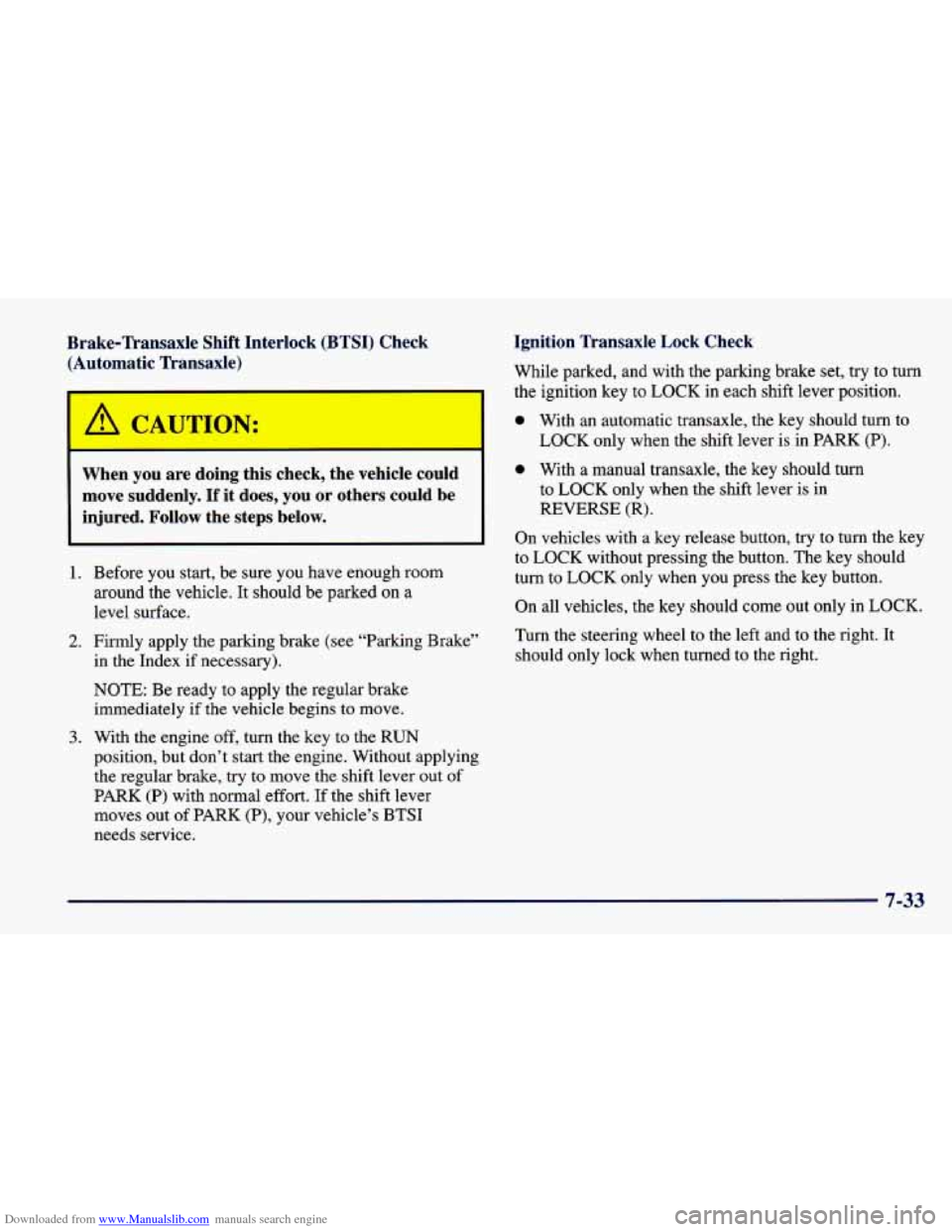
Downloaded from www.Manualslib.com manuals search engine Brake-Transaxle Shift Interlock (BTSI) Check (Automatic Transaxle)
r
A CAUTION:
When you are doing this check, the vehicle could
move suddenly. If it does, you or others could be
injured. Follow the steps below.
1.
2.
3.
Before you start, be sure you have enough room
around the vehicle.
It should be parked on a
level surface.
Firmly apply the parking brake (see “Parking Brake’’
in the Index if necessary).
NOTE: Be ready to apply the regular brake
immediately if the vehicle begins to move.
With the engine off, turn the key to the RUN
position, but don’t start the engine. Without applying
the regular brake, try to move the shift lever out of
PARK
(P) with normal effort. If the shift lever
moves out of PARK (P), your vehicle’s BTSI
needs service.
Ignition Transaxle Lock Check
While parked, and with the parking brake set, try to turn
the ignition key to LOCK in each shift lever position.
0 With an automatic transaxle, the key should turn to
LOCK only when the shift lever
is in PARK (P).
0 With a manual transaxle, the key should turn
to
LOCK only when the shift lever is in
REVERSE (R).
On vehicles with a key release button, try to turn the key
to LOCK without pressing the button. The key should
turn to
LOCK only when you press the key button.
On all vehicles, the key should come out only in
LOCK.
Turn the steering wheel to the left and to the right. It
should only lock when turned to the right.
7-33
Page 388 of 400
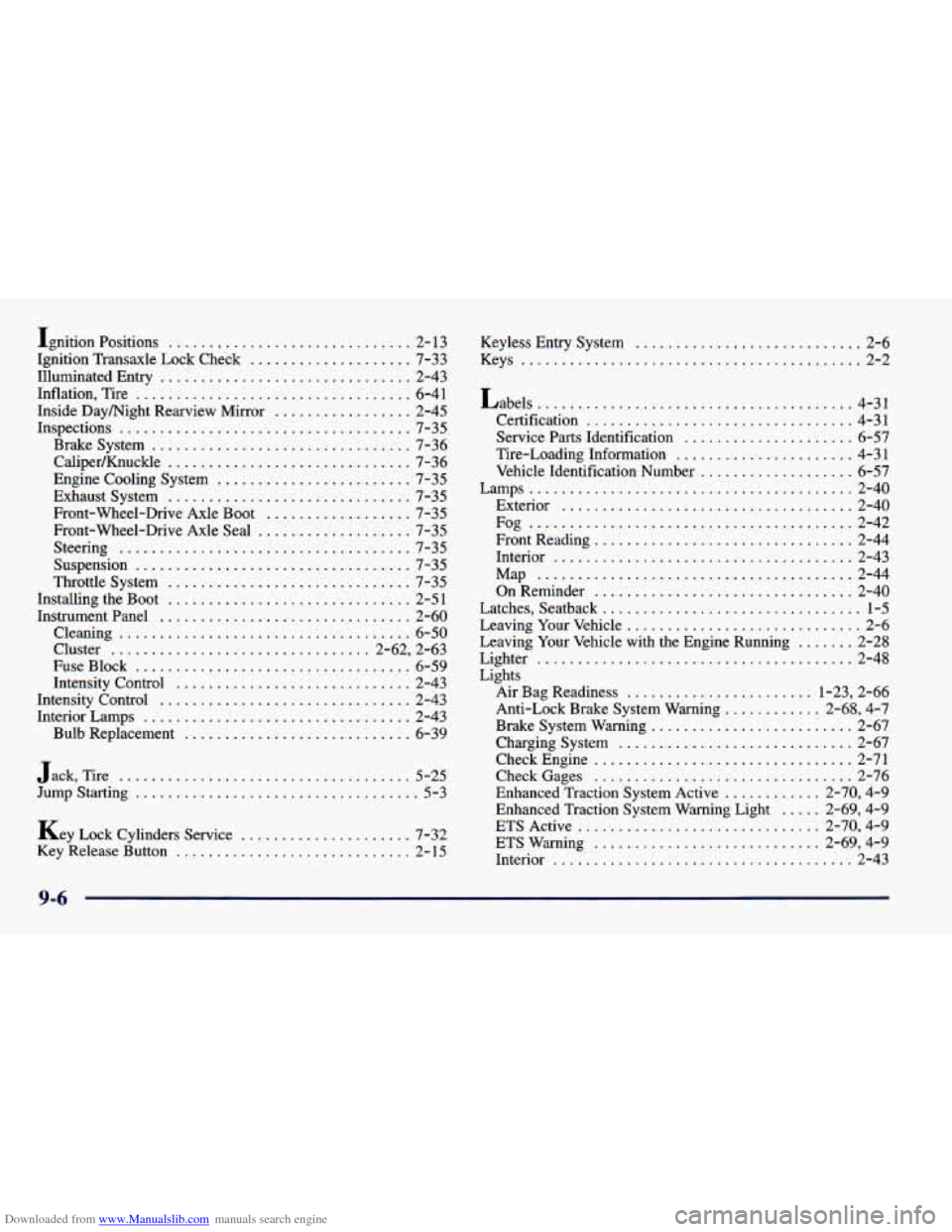
Downloaded from www.Manualslib.com manuals search engine Ignition Positions .............................. 2- 13
Ignition Transaxle Lock Check
.................... 7-33
Illuminated Entry
............................... 2-43
Inflation. Tire
.................................. 6-41
Inside Daymight Rearview Mirror
................. 2-45
Inspections
.................................... 7-35
Brake System
................................ 7-36
CaliperIKnuckle
.............................. 7-36
Engine Cooling System
........................ 7-35
Exhaust System
.............................. 7-35
Front-Wheel-Drive Axle Boot
.................. 7-35
Front-Wheel-Drive Axle Seal
................... 7-35
Steering
.................................... 7-35
Suspension
.................................. 7-35
Throttle System
.............................. 7-35
Installing the Boot
.............................. 2-51
Instrumentpanel
............................... 2-60
Cleaning
.................................... 6-50
Cluster ................................ 2-62. 2-63
FuseBlock
.................................. 6-59
Intensity Control
............................. 2-43
Intensity Control
............................... 2-43
Interior Lamps
................................. 2-43
Bulb Replacement
............................ 6-39
Jack. Tire
.................................... 5-25
Jump Starting
................................... 5-3
Key Lock Cylinders Service
..................... 7-32
Key Release Button
............................. 2- 15 Keyless Entry
System
............................ 2-6
Keys
.......................................... 2-2
Labels
....................................... 4-31
Certification
................................. 4-31
Service Parts Identification
..................... 6-57
Tire-Loading Information
...................... 4-31
Vehicle Identification Number
................... 6-57
Lamps
........................................ 2-40
Exterior
.................................... 2-40
FrontReading
................................ 2-44
Interior
..................................... 2-43
OnReminder
................................ 2-40
Latches, Seatback
................................ 1-5
Leaving Your Vehicle
............................. 2-6
Leaving Your Vehicle with the Engine Running
....... 2-28
Lighter
....................................... 2-48
Lights
Air Bag Readiness
....................... 1-23, 2-66
Anti-Lock Brake System Warning
............ 2-68, 4-7
Brake System Warning
......................... 2-67
Charging System
............................. 2-67
CheckEngine
................................ 2-71
Enhanced Traction System Active
............ 2-70, 4-9
Enhanced Traction System Warning Light ..... 2-69, 4-9
ETS Active .............................. 2-70, 4-9
ETS Warning
............................ 2-69, 4-9
Interior
..................................... 2-43
Fog
........................................ 2-42
Map
....................................... 2-44
CheckGages
................................ 2-76
9-6
Page 392 of 400
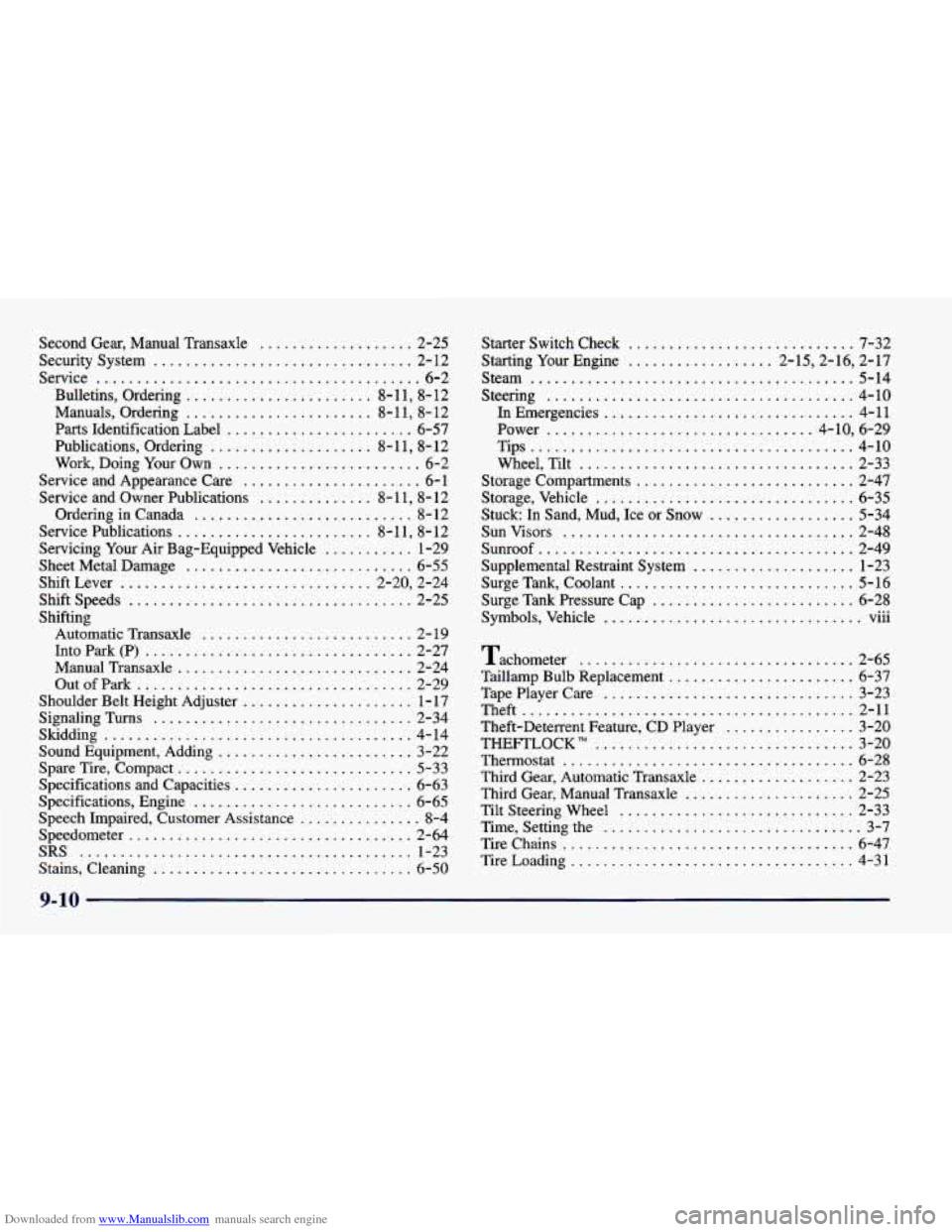
Downloaded from www.Manualslib.com manuals search engine Second Gear. Manual Transaxle ................... 2-25
Security System
................................ 2-12
Service
........................................ 6-2
Bulletins. Ordering
....................... 8-1 1. 8- 12
Parts Identification Label
....................... 6-57
Publications. Ordering
.................... 8-1 1. 8- 12
Work. Doing Your Own
......................... 6-2
Service and Appearance Care
...................... 6-1
Service and Owner Publications
.............. 8- 1 1. 8- 12
OrderinginCanada
........................... 8-12
Service Publications
........................ 8- 11. 8- 12
Sheet Metal Damage
............................ 6-55
ShiftLever
............................... 2-20. 2-24
Shiftspeeds
................................... 2-25
Shifting Automatic Transaxle
.......................... 2- 19
Into Park
(P) ................................. 2-27
Manual Transaxle
............................. 2-24
OutofPark
.................................. 2-29
Shoulder Belt Height Adjuster
..................... 1-17
Signaling Turns
................................ 2-34
Skidding
...................................... 4- 14
Sound Equipment. Adding
........................ 3-22
Spare Tire. Compact
............................. 5-33
Specifications and Capacities
...................... 6-63
Specifications. Engine
........................... 6-65
Speedometer
................................... 2-64
SRS ......................................... 1-23
Stains. Cleaning
................................ 6-50
Manuals. Ordering
....................... 8- 11 . 8- 12
Servicing Your Air Bag-Equipped Vehicle
........... 1-29
Speech Impaired. Customer Assistance
............... 8-4 Starter Switch Check
............................ 7-32
Starting Your Engine
.................. 2.15.2.16. 2.17
Steam
........................................ 5-14
Steering ...................................... 4-10
In Emergencies
............................... 4-11
Power
................................. 4.10. 6.29
Tips
........................................ 4-10
Wheel. Tilt
.................................. 2-33
Storage Compartments
........................... 2-47
Storage. Vehicle
................................ 6-35
Stuck: In Sand. Mud. Ice
or Snow .................. 5-34
Sunvisors
.................................... 2-48
Sunroof
....................................... 2-49
Supplemental Restraint System
.................... 1-23
Surge Tank. Coolant
............................. 5-16
Surge Tank Pressure Cap
......................... 6-28
Symbols. Vehicle vlu e.. ................................
Tachometer .................................. 2-65
Taillamp Bulb Replacement
....................... 6-37
TapePlayerCare
............................... 3-23
Theft
......................................... 2-11
Theft-Deterrent Feature. CD Player
................ 3-20
Thermostat
.................................... 6-28
Third Gear. Automatic Transaxle
................... 2-23
Third Gear. Manual Transaxle
..................... 2-25
Tilt Steering Wheel
............................. 2-33
Time. Setting the
................................ 3-7
Tirechains
.................................... 6-47
TireLoading
................................... 4-31
THEFTLOCK"
................................ 3-20
9-10